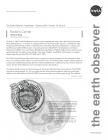The Earth Observer has a new look! Visit the NEW Earth Observer website.
The Earth Observer: Sep - Oct, 2007
In This Issue
Click title below to view page
- Editor’s Corner Front Cover
- Feature Articles
- Ocean Surface Topography: Past, Present, and Future4
- Dutch Students Contribute to OMI Aerosol Validation7
- Changing Arctic Observed by CERES Instruments and MODIS10
- Expedition to Siberia: A Firsthand Account13
- Interpreting Land Cover Change by Combining NASA and Commercial Satellite Data22
- NASA DEVELOP Students Use EOS Data to Study Air Quality on the U.S.–Canadian Border25
- Meeting/Workshop Summaries
- Summary of the 31st ASTER Science Team Meeting28
- OMI Science Team Meeting Overview30
- Landsat Science Team Meeting Summary36
- In The News
- Scouting Out Aerosols in Oklahoma: NASA Langley Researchers Use Lidar to Support Department of Energy Field Campaigns42
- NASA Web Page, Video Gives Educators An In-Depth Look At Hurricanes44
- Billowing Smoke Blankets Montana and Idaho45
- NASA Helps Texas Respond to Most Widespread Flooding in 50 Years46
- Long-Term Increase in Rainfall Seen in Tropics48
- ESIP Federation Elects New Leadership50
- Regular Features
- EOS Scientists in the News52
- NASA Science Mission Directorate—Science Education Update54
- Science Calendars55
Editor’s Corner
Michael King, EOS Senior Project Scientist
On June 15, 2007, NASA Headquarters released a report compiling the results of the 2007 Earth Science Senior Review held April 25-27, to evaluate 11 ongoing NASA Earth observing satellite missions—ACRIMSAT; Aqua; CloudSat; Earth Observing-1 (EO-1); Gravity Recovery and Climate Experiment (GRACE); Ice, Clouds, and land Elevation Satellite (ICESat); Jason-1; Quick Scatterometer (QuikSCAT); Solar Radiation and Climate Experiment (SORCE); Terra; and Tropical Rainfall Measuring Mission (TRMM). Eight of these missions are now operating beyond their prime mission periods, while Aqua, CloudSat, and SORCE will transition to extended mission mode between Fiscal Year (FY) 2008 and FY 2009.
The Call for Proposals directed the mission teams to prepare two separate proposals: one for continuation of the basic or core mission and the other for an enhanced mission. The core mission includes...
Read more...

